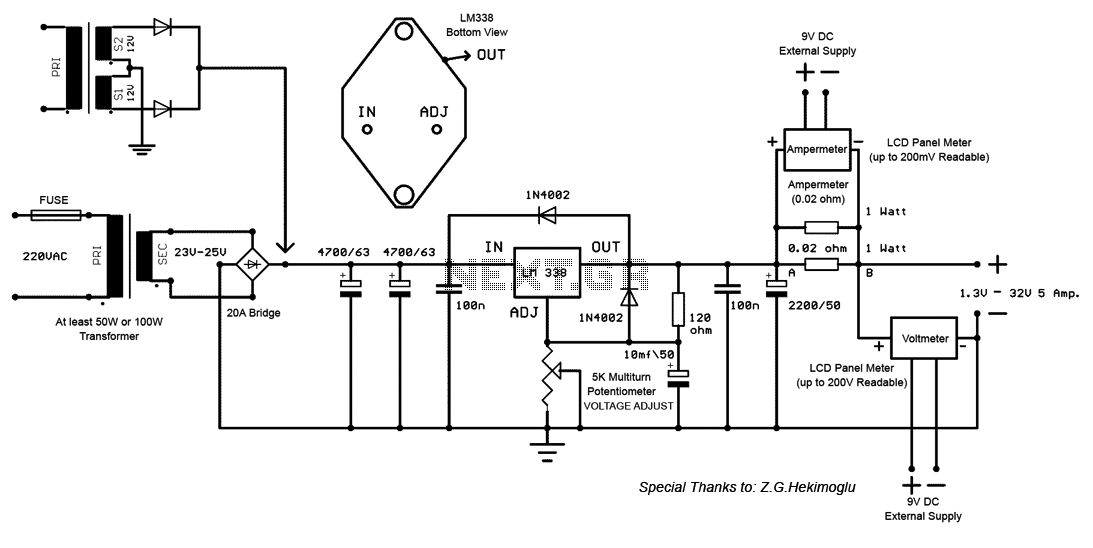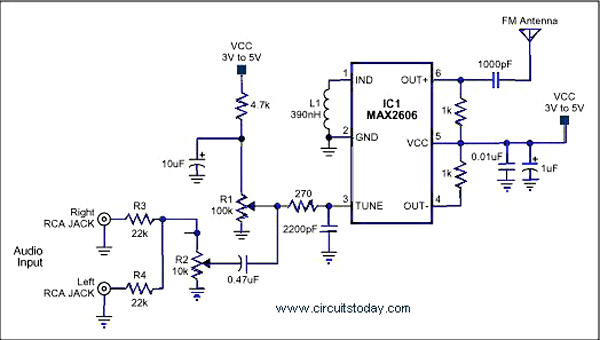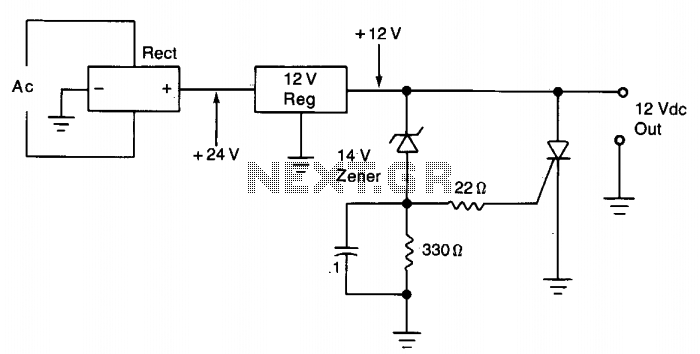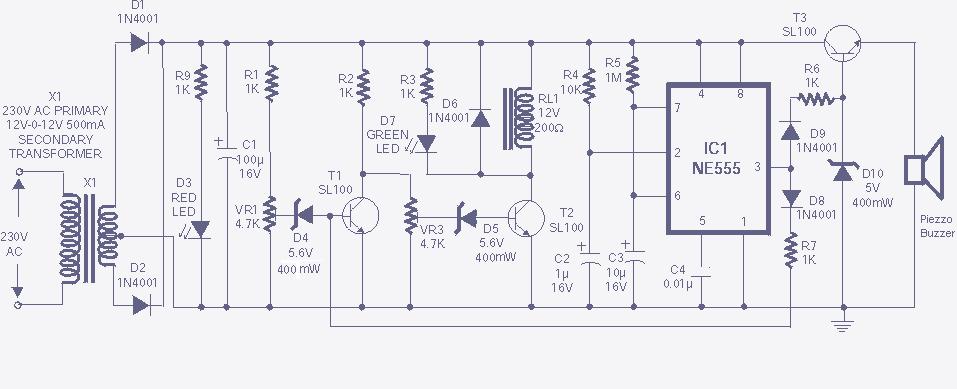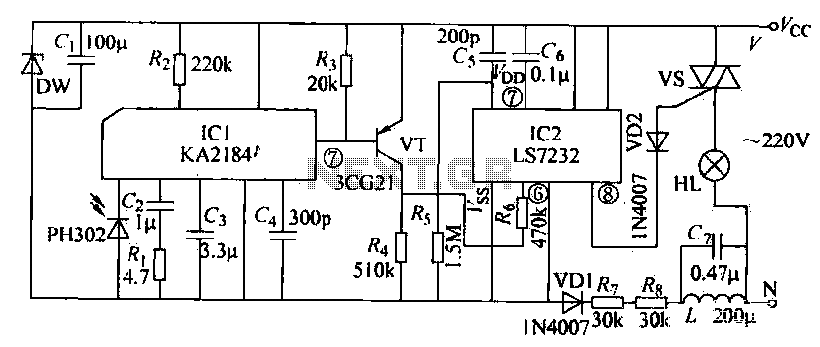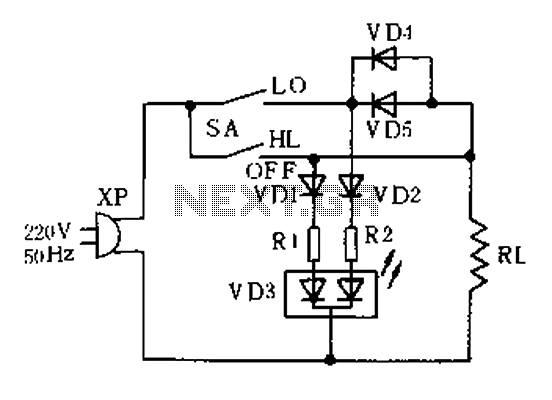
Battery Level Monitor Circuit
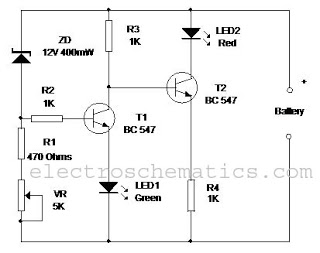
This circuit monitors the charging process of a 12 Volt Lead Acid or Tubular battery. The LED status indicates whether the battery is charging and signals when it reaches a full charge. It can be integrated into various battery chargers (6V, 9V, 12V) by simply replacing the Zener diode (ZD) with an appropriate value. For a 6V charger, a 6.1V Zener is required, and for a 9V charger, a 9.1V Zener is needed. The circuit operates using two NPN transistors (BC547) to control the LEDs. The Zener diode ZD connects to the base of transistor T1, activating it when the Zener conducts, which occurs when the battery voltage exceeds 12 volts. The green LED illuminates when the battery voltage is normal or fully charged. Resistor R1 and potentiometer VR adjust the base bias of T1 for smooth switching. When T1 is active, the base of T2 is grounded, turning T2 off and extinguishing the red LED. When the battery is connected to the charger and is accepting charge, the green LED turns off while the red LED remains illuminated. Once the battery reaches full charge, the green LED lights up, and the red LED turns off. If the battery does not accept charge, the green LED will not illuminate, indicating that the battery is not achieving the normal terminal voltage above 12 volts.
The circuit is designed to provide an effective visual indication of the charging status of a 12V Lead Acid or Tubular battery. It utilizes two NPN transistors (BC547) for switching, which enhances the reliability and responsiveness of the LED indicators. The Zener diode plays a crucial role in voltage regulation, ensuring that T1 is activated only when the battery voltage exceeds the specified threshold. This feature prevents false indications during low voltage conditions.
In practical implementation, the circuit can be adapted to different voltage levels by selecting appropriate Zener diodes. For instance, using a 6.1V Zener diode for a 6V charger or a 9.1V Zener for a 9V charger allows for versatility across various charging applications. The inclusion of a resistor (R1) and a variable resistor (VR) enables fine-tuning of the biasing conditions for T1, which is essential for optimizing the switching characteristics and ensuring that the LEDs operate smoothly without flickering.
The operational states of the LEDs provide clear and immediate feedback to the user. The green LED signifies that the battery is either in a normal operating range or fully charged, while the red LED indicates that the battery is currently charging. The design also incorporates a fail-safe feature, where the absence of the green LED illumination suggests that the battery is not accepting charge, prompting further investigation into the battery's health or the charger’s functionality.
Overall, this circuit is a practical solution for monitoring battery charging processes, providing essential feedback through simple LED indicators, and it can be easily adapted for various charging systems by modifying the Zener diode component.This simple circuit can monitor the charging process in 12 Volt Lead Acid battery or Tubular battery. The status of LED indicates whether the battery is accepting charge or not. It also indicates the full charge condition. The circuit can be incorporated in any battery charger like 6 volt, 9 volt, 12 volt etc. The only change needed is replacement of the Zener ZD with appropriate value. That is for 6 volt charger, use 6. 1 volt Zener and for 9 volt charger it should be 9. 1 volt Zener. The circuit is based on the switching of two NPN transistors (BC547) to drive the corresponding LED. Zener diode ZD is connected to the base of T1 so as to switch on T1 when the Zener conducts. This happens only when the battery voltage is above 12 volts. Green LED lights when the battery voltage is normal or battery attains full charge. Resistor R1 and Preset VR adjust the base bias of T1 for smooth switching. When T1 conducts, base of T2 will be pulled to ground and T2 turns off and Red LED extinguishes. 3. When the battery is connected to the charger, and if the battery is accepting charge, Green LED goes off and Red LED remains on. When the battery attains full charge, Green LED lights and Red LED goes off. 4. If the battery is not accepting charge, Green LED never lights, even after the prolonged charging. This indicates that the battery is not attaining the normal terminal voltage above 12 volts. 🔗 External reference
The circuit is designed to provide an effective visual indication of the charging status of a 12V Lead Acid or Tubular battery. It utilizes two NPN transistors (BC547) for switching, which enhances the reliability and responsiveness of the LED indicators. The Zener diode plays a crucial role in voltage regulation, ensuring that T1 is activated only when the battery voltage exceeds the specified threshold. This feature prevents false indications during low voltage conditions.
In practical implementation, the circuit can be adapted to different voltage levels by selecting appropriate Zener diodes. For instance, using a 6.1V Zener diode for a 6V charger or a 9.1V Zener for a 9V charger allows for versatility across various charging applications. The inclusion of a resistor (R1) and a variable resistor (VR) enables fine-tuning of the biasing conditions for T1, which is essential for optimizing the switching characteristics and ensuring that the LEDs operate smoothly without flickering.
The operational states of the LEDs provide clear and immediate feedback to the user. The green LED signifies that the battery is either in a normal operating range or fully charged, while the red LED indicates that the battery is currently charging. The design also incorporates a fail-safe feature, where the absence of the green LED illumination suggests that the battery is not accepting charge, prompting further investigation into the battery's health or the charger’s functionality.
Overall, this circuit is a practical solution for monitoring battery charging processes, providing essential feedback through simple LED indicators, and it can be easily adapted for various charging systems by modifying the Zener diode component.This simple circuit can monitor the charging process in 12 Volt Lead Acid battery or Tubular battery. The status of LED indicates whether the battery is accepting charge or not. It also indicates the full charge condition. The circuit can be incorporated in any battery charger like 6 volt, 9 volt, 12 volt etc. The only change needed is replacement of the Zener ZD with appropriate value. That is for 6 volt charger, use 6. 1 volt Zener and for 9 volt charger it should be 9. 1 volt Zener. The circuit is based on the switching of two NPN transistors (BC547) to drive the corresponding LED. Zener diode ZD is connected to the base of T1 so as to switch on T1 when the Zener conducts. This happens only when the battery voltage is above 12 volts. Green LED lights when the battery voltage is normal or battery attains full charge. Resistor R1 and Preset VR adjust the base bias of T1 for smooth switching. When T1 conducts, base of T2 will be pulled to ground and T2 turns off and Red LED extinguishes. 3. When the battery is connected to the charger, and if the battery is accepting charge, Green LED goes off and Red LED remains on. When the battery attains full charge, Green LED lights and Red LED goes off. 4. If the battery is not accepting charge, Green LED never lights, even after the prolonged charging. This indicates that the battery is not attaining the normal terminal voltage above 12 volts. 🔗 External reference
